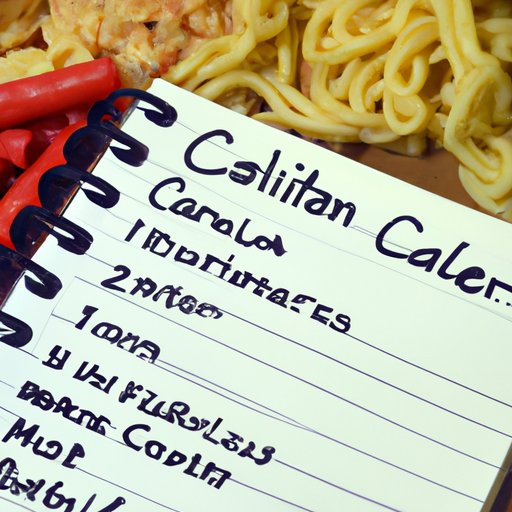
I. Introduction
Gaining weight can be just as challenging as losing it. Many people struggle to gain weight, no matter how much they eat. If you are one of those people, you are not alone. Luckily, a healthy weight gain can be achieved with the right knowledge and strategy. In this article, we will guide you through the process of how to calculate how many calories to eat to gain weight and optimize your health.
II. Importance of Tracking Calories
Tracking calories is an essential part of a successful weight gain journey. It helps you to determine how much you are eating and identify nutrient deficiencies or overconsumption. When you want to gain weight, you need to make sure that you are eating enough to create a calorie surplus, which is necessary for building muscle mass and increasing your body weight.
A calorie surplus means that you consume more calories than your body burns. To gain one pound of weight, you need to consume an excess of 3,500 calories. So, if you aim to gain one pound per week, you need to consume an additional 500 calories per day.
III. High Calorie Foods
High calorie foods are foods that contain a lot of calories per serving or weight. These foods can help you achieve your daily calorie needs quickly. Examples of high calorie foods include:
- Nuts and nut butter
- Avocados
- Cheese
- Whole grains and bread
- Fatty fish, such as salmon
- Dried fruits
- Dark chocolate
- Full-fat dairy products
You can easily incorporate these high calorie foods into your daily meals. For example, adding avocado to your sandwich, snacking on nuts, or incorporating cheese in your pasta dish can be an excellent way to increase your calorie intake and nutrient intake.
IV. Calorie Surplus
To gain weight in a healthy way, you need to create a calorie surplus. A calorie surplus means that you consume more calories than your body burns. To determine your daily calorie needs for weight gain, you need to calculate your Basal Metabolic Rate (BMR) and the number of calories you burn per day with regular physical activities, also known as Total Daily Energy Expenditure (TDEE).
The BMR is the number of calories your body needs to function at rest, while TDEE is the number of calories you need to maintain your current weight. To gain weight, you need to consume 250 to 500 calories more than your TDEE per day. This caloric range helps you to gain 0.5 to 1 pound per week.
V. Creating a Meal Plan
Creating a meal plan can help you to stay on track with your calorie and nutrient intake. To create a meal plan that fits your calorie needs, follow these steps:
- Calculate your BMR and TDEE using an online calculator
- Determine your daily calorie intake for weight gain by adding 250 to 500 calories to your TDEE
- Distribute your calorie intake to three main meals and two to three snacks per day
- Incorporate high calorie foods into every meal
- Make sure that you consume the right amount of proteins, carbohydrates, and fats
- Plan your meals ahead for easy preparation
Tracking your macros and micronutrients can help ensure that you are consuming the right amount of calories from essential nutrients. Proteins are essential for building muscle mass, while carbohydrates provide energy to fuel your workouts and daily activities. Fats are also crucial for hormone production and nutrient absorption. Aim for a balanced macronutrient ratio of 40:40:20 for carbohydrates, proteins, and fats, respectively.
VI. Tracking Progress
Tracking your progress can help you stay motivated and make changes based on the results. You can measure your progress by tracking your weight, body measurements, and physical performance. It is also essential to take progress photos and track how you feel mentally and physically.
Remember that gaining weight takes time and patience. A healthy weight gain is approximately 0.5 to 1 pound per week. Don’t get discouraged if you don’t see immediate results. Consistency is the key to success.
VII. Dangers of Consuming Too Many Calories
Consuming too many calories can lead to weight gain, and it can also lead to health problems such as heart disease, diabetes, and high blood pressure. It is important to determine the right amount of calories to consume based on individual needs. If you are unsure how many calories you should eat, consult a registered dietitian or a healthcare professional.
VIII. Sample Meal Plan
Here is a sample meal plan for weight gain:
Breakfast:
- 2 slices of whole grain bread with 2 tablespoons of peanut butter
- 1 medium banana
- 1 cup of whole milk
Morning Snack:
- 1 cup of Greek yogurt with mixed berries and 1 tablespoon of honey
Lunch:
- 2 slices of whole grain bread with 2 slices of cheese and 3 slices of turkey
- 1 medium apple
- 1 cup of vegetable soup
Afternoon Snack:
- 1 ounce of mixed nuts
Dinner:
- 4 ounces of grilled chicken breast
- 1 cup of quinoa
- 1 cup of roasted vegetables
- 1 tablespoon of olive oil
Evening Snack:
- 1 cup of sliced strawberries with 1 cup of whole milk
- 1 small square of dark chocolate
IX. Conclusion
Gaining weight requires a calorie surplus, which can be achieved by consuming the right amount of calories from nutrient-rich foods. Tracking your calories and progress can help you to stay on track and make adjustments where necessary. Creating a meal plan and incorporating high calorie foods can help you to gain weight and reach your health goals. Remember that consistency and patience are the keys to success. Use this guide to achieve a healthy weight gain and become the best version of yourself.





